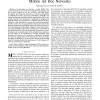6894 search results - page 82 / 1379 » On network interference management |
108
click to vote
TIT
2010
14 years 4 months ago
2010
We study cellular-like wireless networks in which the cells may overlap substantially, and a common channel is used for all cells. Thus, transmissions intended for one destination ...
PIMRC
2008
IEEE
15 years 4 months ago
2008
IEEE
—The purpose of this paper is to compare two interference avoidance techniques for time division duplex (TDD) wireless networks, viz.: a novel technique termed asymmetry balancin...
SECON
2007
IEEE
15 years 4 months ago
2007
IEEE
— The rapidly growing demand for wireless communication makes efficient power allocation a critical factor in the network’s efficient operation. Recently power allocation in ...
107
click to vote
TWC
2008
14 years 9 months ago
2008
Spectrum sensing is the key enabling technology for cognitive radio networks. The main objective of spectrum sensing is to provide more spectrum access opportunities to cognitive r...
101
click to vote
JSAC
2007
14 years 9 months ago
2007
Abstract— In this paper, we develop a coded MIMO FHCDMA transceiver that is robust to partial-band jamming and the near-far problem for ad hoc networks with high mobility. Spatia...

